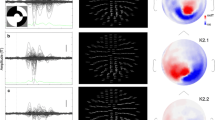Summary
Analysis of published values for the depth profile of evoked potentials in primary sensory cortex of cat and monkey provide a consistent estimate for the net current dipole moment per unit area of cortical surface. Comparison with values of the total current dipole moment obtained from neuromagnetic studies on human subjects indicates that coherent neuronal activity giving rise to long-latency sensory evoked components recorded in the human electroencephalogram or magnetoencephalogram extends over a cortical area that is typically ∼40–400 mm2.
Similar content being viewed by others
References
Barth D, Sutherling W (1988) Current source-density and neuro-magnetic analysis of the direct cortical response in rat cortex. Brain Res 450:280–294
Buchanan DS, Crum DB, Cox D, Wikswo JP (1989) MicroSQUID: a close-spaced four channel magnetometer. In: Williamson SJ, Hoke M, Stroink G, Kotani M (eds) Advances in biomagnetism. Plenum, New York, pp 677–679
Cauller LJ, Kulics AT (1991) The neural basis of the behaviorally relevant N1 component of the somatosensory-evoked potential in SI cortex of awake monkeys: evidence that backward cortical projections signal conscious touch sensation, submitted
Curtis S, Kaufman L, Williamson SJ (1988) Divided attention revisited: selection based on location or pitch. In: Atsumi K, Kotani M, Ueno S, Katila T, Williamson SJ (eds) Biomagnetism '87. Tokyo Denki University Press, Tokyo, pp 138–141
Hari R, Aittoniemi K, Järvinen M-L, Katila T, Varpula T (1980) Auditory evoked transient and sustained magnetic fields of the human brain. Exp Brain Res 40:237–240
Hoeltzell PB, Dykes RW (1979) Conductivity in the somatosensory cortex of the cat: evidence for cortical anisotropy. Brain Res 177:61–82
Huang J-C, Nicholson C, Okada Y (1990) Distortion of magnetic evoked fields and surface potentials by conductivity differences at boundaries in brain tissue. Biophys J (in press)
Mitzdorf U, Singer W (1979) Excitatory synaptic ensemble properties in the visual cortex of the macaque monkey: a current source density analysis of electrically evoked potentials. J Comp Neurol 187:71–84
Mitzdorf U (1987) Properties of the evoked potential generators: current source density analysis of visually evoked potentials in the cat cortex. Int J Neurosci 33:33–59
Mountcastle V (1979) An organizing principle for cerebral function: the unit module and the distributed system. In: Schmidt FO, Worden FG (eds) The neurosciences, fourth study program. MIT Press, Cambridge, Ma, pp 21–42
Nicholson C, Freeman JA (1975) Theory of current source-density analysis and determination of conductivity tensor for anuran cerebellum. J Neurophysiol 38:356–368
Okada Y (1985) Discrimination of localized and extended current dipole sources and localized single and multiple sources. In: Weinberg H, Stroink G, Katila T (eds) Biomagnetism: applications and theory. Pergamon Press, New York, pp 266–272
Okada Y (1989) Recent developments on the physiological basis of magnetoencephalography (MEG). In: Williamson SJ, Hoke M, Stroink G, Kotani M (eds) Advances in biomagnetism. Plenum, New York, pp 273–278
Pantev C, Hoke M, Lütkenhöner B, Lehnertz K (1988) Influence of stimulus intensity on the location of the equivalent current dipole in the human auditory cortex. In: Atsumi K, Kotani M, Ueno S, Katila T, Williamson SJ (eds) Biomagnetism '87. Tokyo Denki University Press, Tokyo, pp 146–149
Plonsey RW (1981) Generation of magnetic fields by the human body (theory). In: Erné SN, Hahlbohm H-D, Lübbig H (eds) Biomagnetism. Walter de Gruyter, Berlin, pp 177–205
Rockel AJ, Hiorns RW, Powell TPS (1980) The basic uniformity in structure of the neocortex. Brain 103:221–244
Romani GL, Williamson SJ, Kaufman L, Brenner D (1982) Characterization of the human auditory cortex by the neuro-magnetic method. Exp Brain Res 47:381–393
Roth BJ, Wikswo JP Jr (1985) The magnetic field of a single axon: a comparison of theory and experiment. Biophy J 48:93–109
Swinney KR, Wikswo JP Jr (1980) A calculation of the magnetic field of a nerve action potential. Biophys J 32:719–732
Wikswo JP Jr, Barach JP, Freeman JA (1980) Magnetic field of a nerve impulse: first measurements. Science 208:53–55
Wikswo JP, Friedman N, Kilroy AW, van Egeraat JM, Buchanan DS (1989) Preliminary measurements with MicroSQUID. In: Williamson SJ, Hoke M, Stroink G, Kotani M (eds) Advances in biomagnetism. Plenum, New York, pp 681–684
Williamson SJ, Hoke M, Stroink G, Kotani M (eds) (1989) Advances in biomagnetism. Plenum, New York
Yamamoto T, Williamson SJ, Kaufman L, Nicholson C, Llinás R (1988) Magnetic localization of neuronal activity in human brain. Proc Natl Acad Sci USA 85:8732–8736
Author information
Authors and Affiliations
Rights and permissions
About this article
Cite this article
Lü, Z.L., Williamson, S.J. Spatial extent of coherent sensory-evoked cortical activity. Exp Brain Res 84, 411–416 (1991). https://doi.org/10.1007/BF00231463
Received:
Accepted:
Issue Date:
DOI: https://doi.org/10.1007/BF00231463




